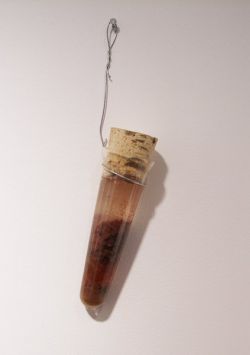Working with his childhood friend, chemist and botanist Joe Piecuch, Elias Hansen celebrates the cheesy weirdness of Tacoma.
Tacoma is the kind of town artists flee from. Art Chantry, who left and came back, refers to it as a “little piece of New Jersey that broke off.” The term flying saucer was coined there in 1947, when a Tacoma man reported seeing silver discs flying over Mount Rainier and along the crest of the Cascade Range. When asked what they looked like, he said, “Like saucers without cups.”
Chantry also claims that the term new age was invented in Tacoma by a splinter group of a flying saucer church. Add the town’s reputation for organized crime, gangs and heavy-industry polluting the waterfront, it’s easy to see why Tacoma had no hope of becoming a city known for art.
Except it has. (Story here.)
Back to Hansen, a glass blower from Pilchuck who never had a decorative thought in his life. He looks at a flourish and wonders how it could be put to use.
He and his older brother Oscar Tuazon come from the Buster Simpson school of handyman poetics. Because Hansen is best known for his collaborations with Tuazon (review here), Hansen’s exhibit at a suitably tacky little Tacoma storefront gallery was a test for him. Has he hitched his wagon to his brother’s star or has he his own forward momentum?
Clearly the latter. With Truths We Forgot To Lie About, he and Piecuch delivered an exhibit of staggering greatness.
They treated Tacoma like a science experiment, taking core samples of the place distilled into gruesome forms of theoretically drinkable beverages.
In all manner of glass test tubes (blown by Hansen), they mixed an alcohol base with Western red cedar, brick fragments from Ted Bundy’s childhood home and soil from Port Madison; coyote blood, beard hair, beeswax and butterfly wings; blackberries, club moss from the Hoh rain forest and hydrogen cyanide; soil from Lewis and Clark’s Cape Disappointment camp site, concrete from the Boeing plant in Everett flavored with hobo urine, and brick chips from Francis Farmer’s childhood home with paint flecks from Curt Cobain’s final abode on Lake Washington.

Beauty, for Hansen, breathes in the forest.
How to keep–is there any any, is there none such, nowhere known some, bow or brooch or braid or brace, lace, latch or catch or key to keep
Back beauty, keep it, beauty, beauty, beauty, … from vanishing away?
from The Leaden Echo and the Golden Echo, Gerald Manley Hopkins
If the beauty of the forest is a commodity in a threatened industry, how can Hansen & Piecuch make use of it in an old loggers’ town?
By turning it into a memory preserved in alcohol. In the hopes of not setting their house on fire, they took a large, Venetian-style glass vase out to the backyard at night and poured hot urethane into it, over the root bulb of a datura plant, from the Nightshade family. The glass cracked, and the pieces fused in layers as the urethane cooled. With that base, they added the ingredients of peach home brew.
From the website of The Helm, the terrific makeshift gallery that sponsored this installation:
Why are bootleggers romanticized? Why are meth cooks ostracized? Why is the Northwest home to so many bootleggers, meth cooks, serial killers and craftspeople? Does the geography of this area create a space for this kind of activity? Or do we create these stories and myths to fit the geography?
Through garage chemistry, traditional craftsmanship, backyard naturopathy and a limited budget, Hansen and Piecuch attempt to assemble a collection of stories, distillations and reactions to the geography and history of the Northwest.
I don’t want to oversell the good news here. The Helm is going out of business after its April show. It’s tough for galleries to stay in business. For a gallery that’s off-the-edge adventurous in Tacoma, it might be near to impossible. RIP, Helm, and come back in another form soon.



Leave a Reply